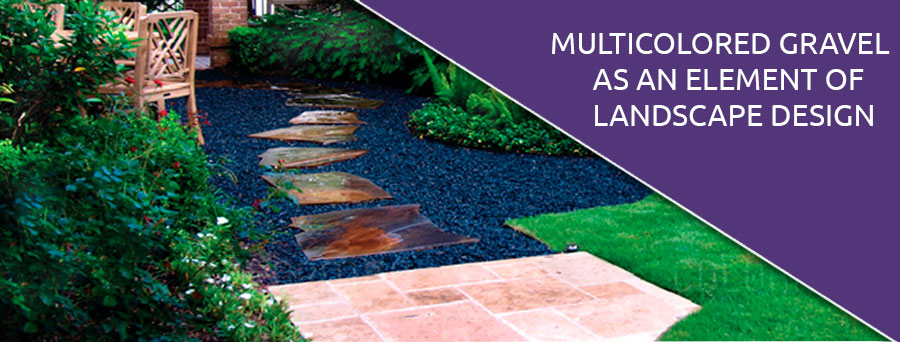The colored gravel is a perfect material for infield, garden or small kitchen garden decoration. Sometimes it is hard to imagine that such a simple material can change the exterior of the area. Gravel is simple and resistant to the environment: rain, snow, heat, and that is important – it is affordable. That is why many people choose gravel to decorate and diversify the landscape of the site, giving it a stylish, unusual appearance.
How to produce a colored rubble?
Gravel is a fractured rock, which is sieved and sorted according to the dimensional form. The colored gravel has recently become selected for further use in landscape design. After processing (sieving and sorting), the gravel is exposed to coloring by polymeric colors, which have a high resistance to adverse environmental conditions and the influence of precipitation. The high quality of the colors makes the material non-toxic and safe to the soil and plants in the vicinity.


What colors to choose for decorating areas?
Designers offer to choose the gravel colored in accordance with the general picture of the courtyard to emphasize and complement the general design of the landscape. Color selection should be based on the ultimate challenge, for example, to create a yard in Japanese style, you can use red and white gravel. Now you can make the material of any color, just paint it, but do not forget about the beauty of natural stone colors: beige, gray, red, white. The combination of white gravel (marble) with any other color looks aesthetically, making the landscape design elegant. For example, designers often create «the effect of the stream» at the desired location of the yard, composing white and blue (cyan) material. Beige shades match with brown and green. You can rotate them to create an abstraction or figures on certain flowerbed.



What mistakes can be allowed to work with rubble?
As the gravel is very simple material, the process of laying is quite simple. However, non-professional designers make the following mistakes.
- The absence of an aligned base. Before gravel lying, the surface must be carefully aligned. If you skip this step, you’ll need more material to use for filling the voids and holes.
- The layer does not pierce the insulating base. Before you lay the gravel in the selected location, the insulating material should be placed, a plastic sheet for example. It is necessary to preserve the structure of the gravel coating, but the holes in a sheet should be pierced for the withdrawal of moisture and dirt, which will appear with the rain. If there are no holes, then the gravel will be covered with a layer of water after the rain, the dust and water will turn into mud, and eventually the gravel will lose its landscaping beauty.
- The layer does not wet the sand. Firstly one must put a layer of sand (five centimeters) on prepared area, and then put the insulating material. It is necessary is to moisten the sand, so as it can be compacted before laying the next layer. If you do not do this, the gravel will begin to fall in malleable sand. It will destroy its beautiful structure.
Landscape design seems to be pretty simple, but it is worth paying attention to all the details for a better result.


How to take care for decorative gravel?
Taking care of decorative gravel is not difficult: it is enough to remove the dirt with water flow. After this procedure, you need to tweak the layer of material with a rake, to restore the broken picture.
 +38 (068) 984 13 17
+38 (068) 984 13 17
